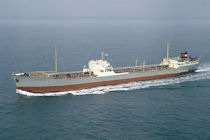
Motortanker „Seestern“,
call sign DABF, 20.301 GRT, started in service 11.10.54 as Norwegian “Bergeland”.
Sold 1968 as “Friedland” to Somalia. 02.03.76 broken up in Mansan/Korea.
Seafaring time: 01.10.66
– 04.02.67
The tanker "Seestern" was at
that time (1966-1967) in possession of the commercial house Helmut Horten,
and was chartered from the shipping firm Fritzen, in Emden.
The ship was built in 1954
in Stavanger/Norway and sailed originally under the Norwegian flag. After
the "Marie Horn", I had the feeling that my next ship would be giant one.
In fact, this large tanker was for that time, "Standard." I went
on board at Dunkirk, and made many voyages between the Persian Golf and
Europe, and one voyage from the Persian Golf and Singapore.
The living quarters on this
ship were for that time very comfortable; living room, bedroom, and bathroom
with shower.